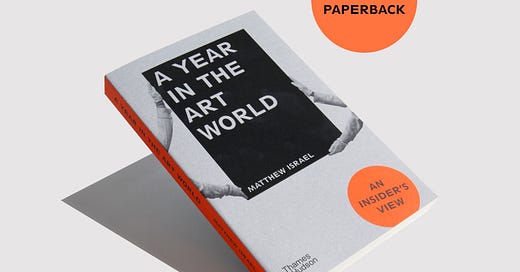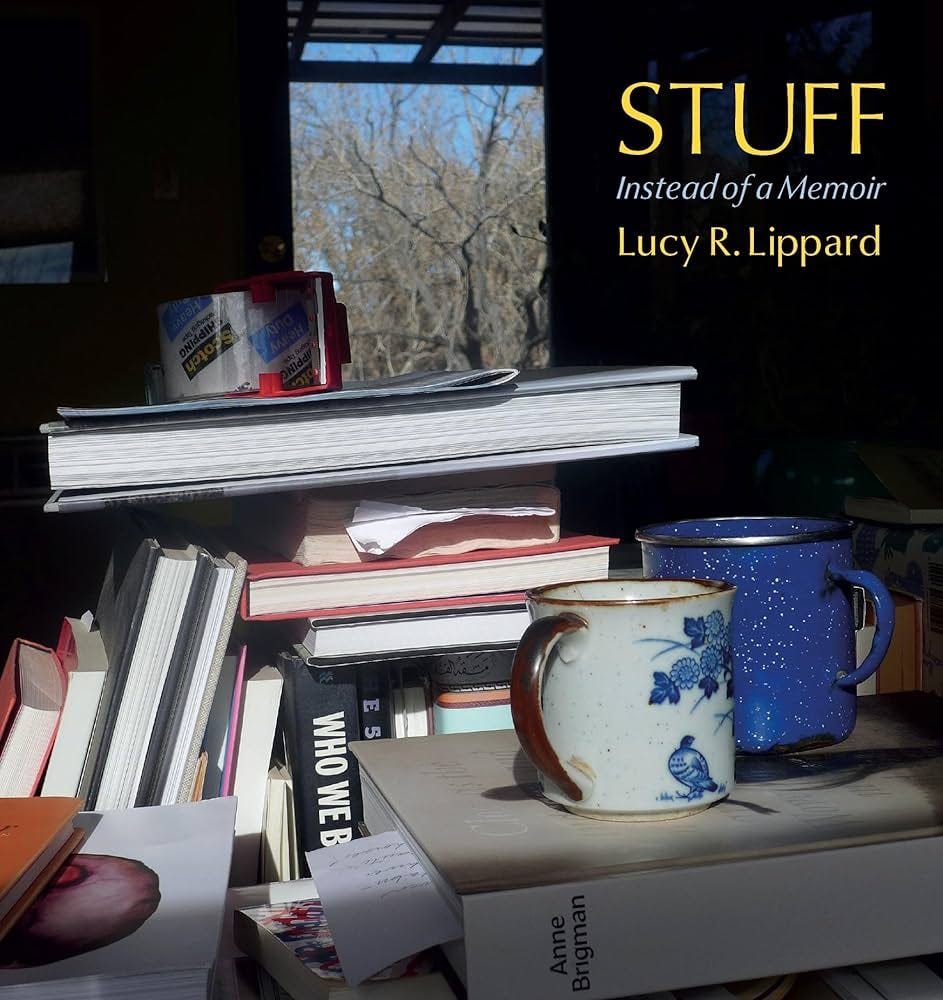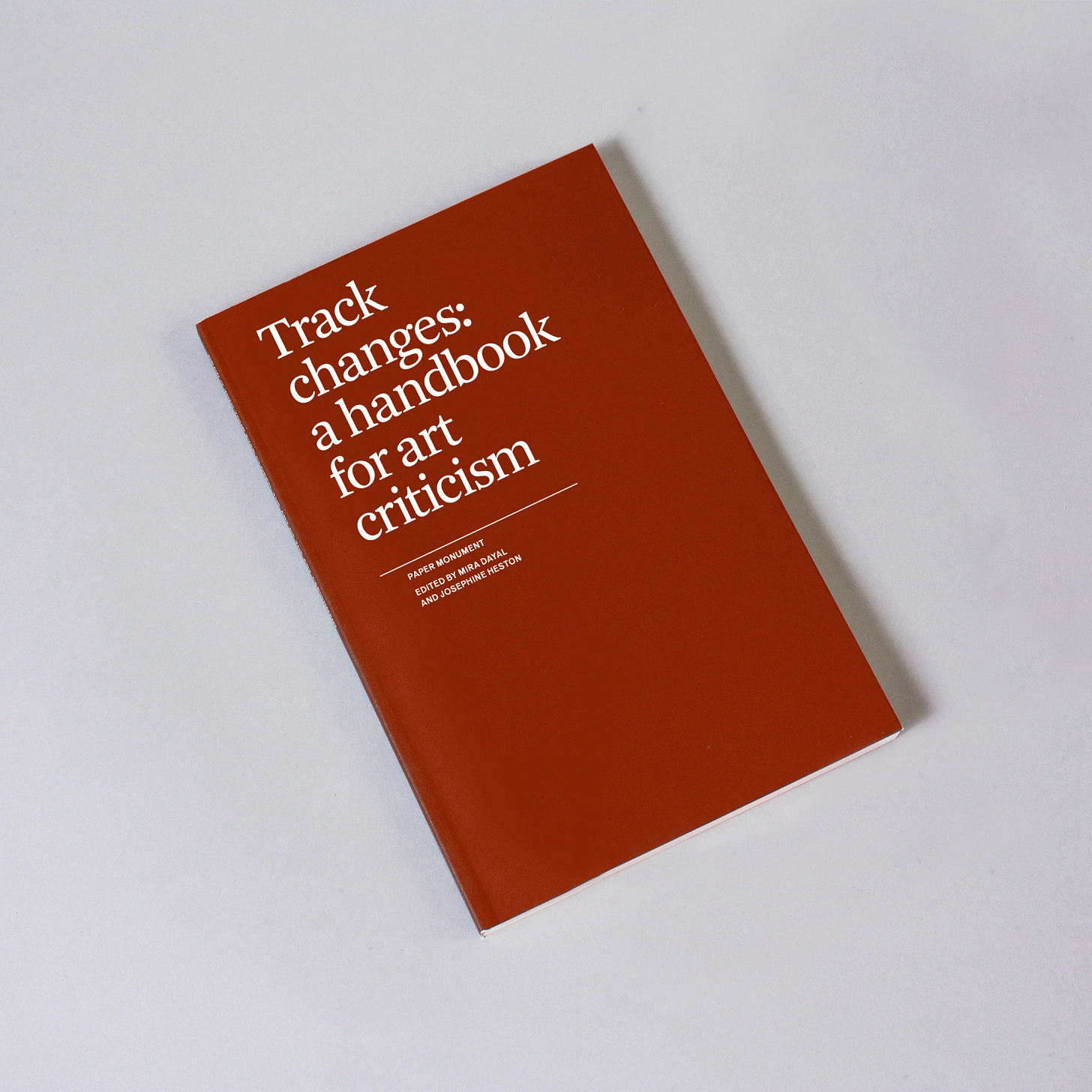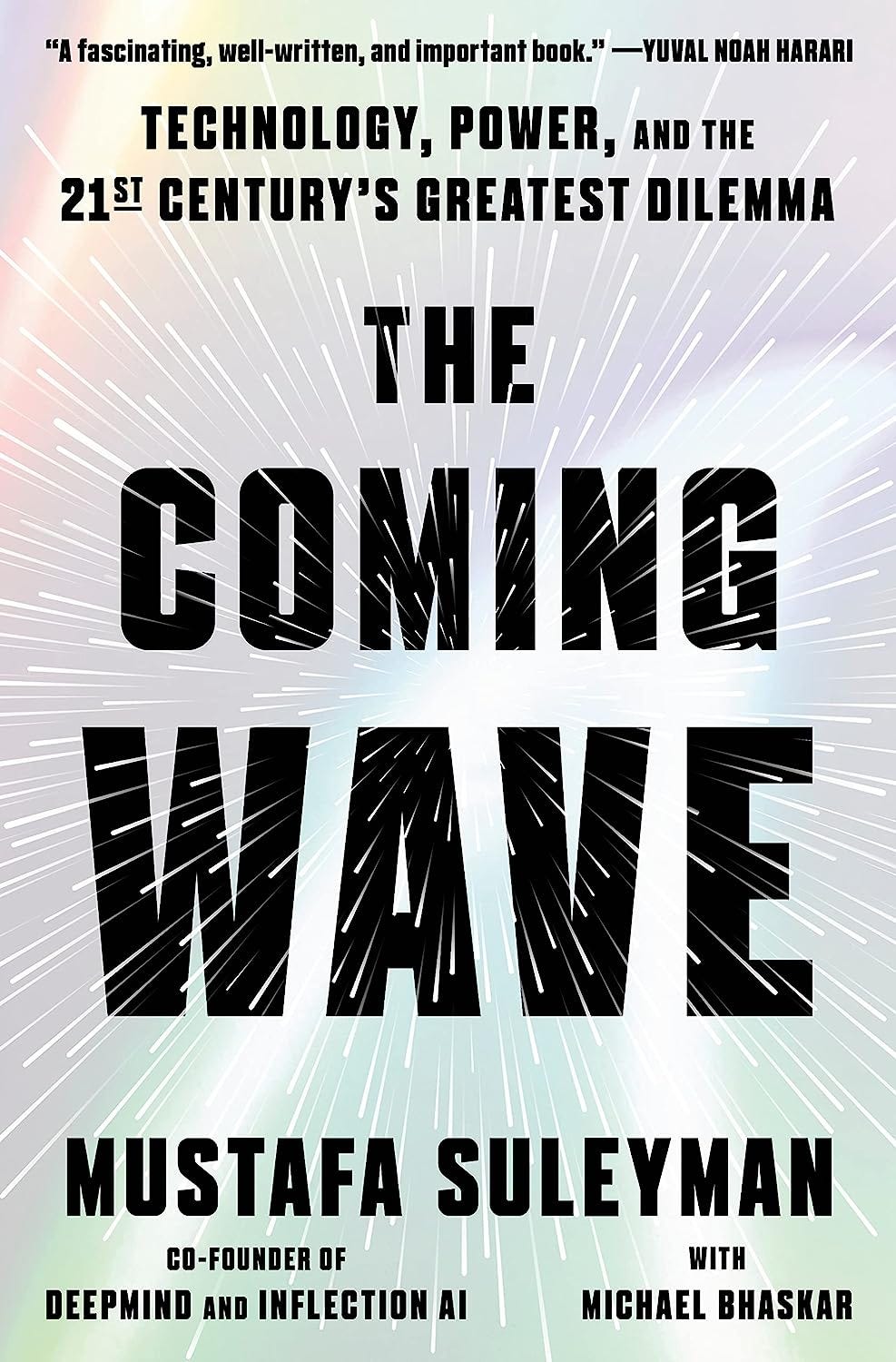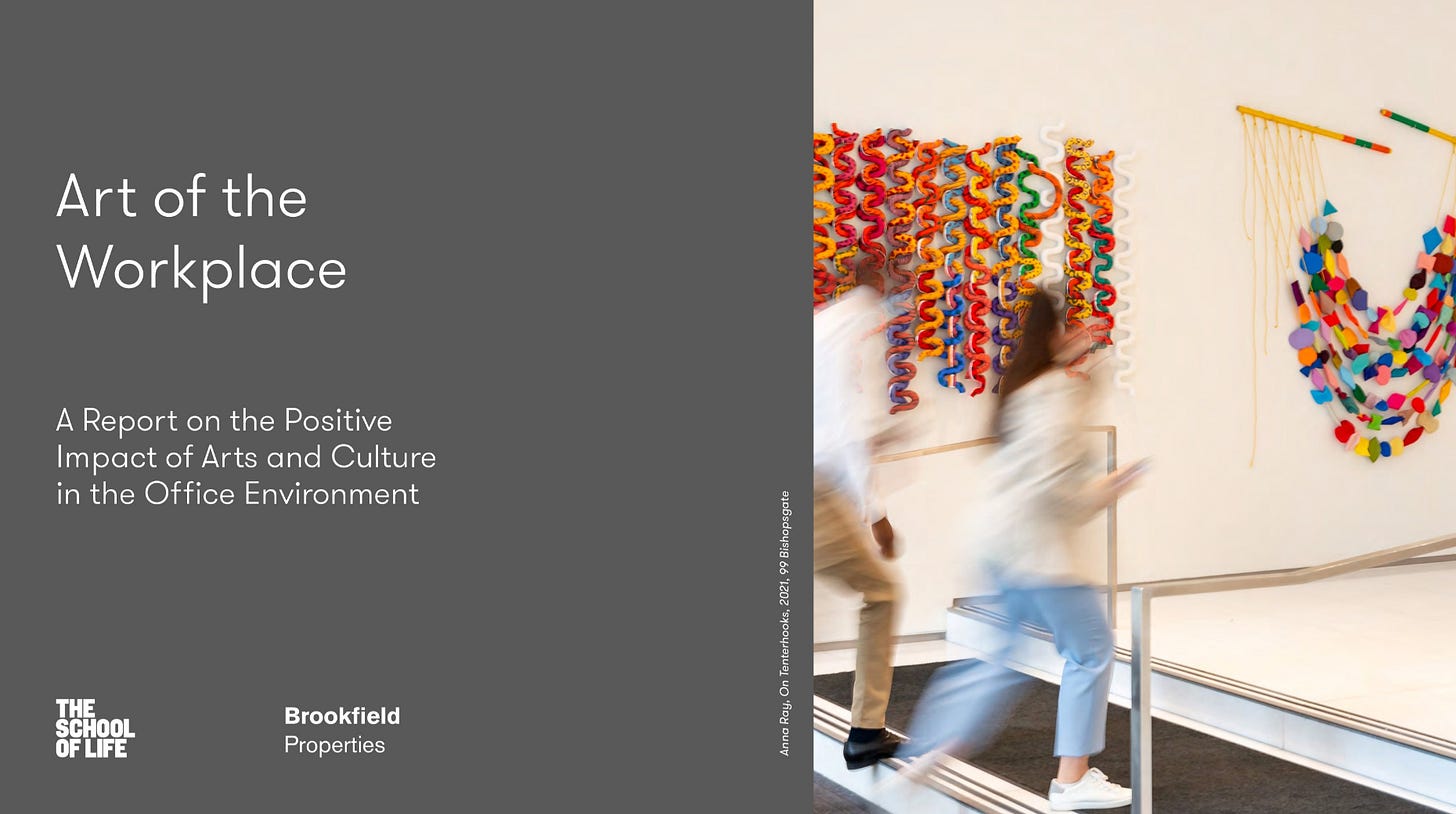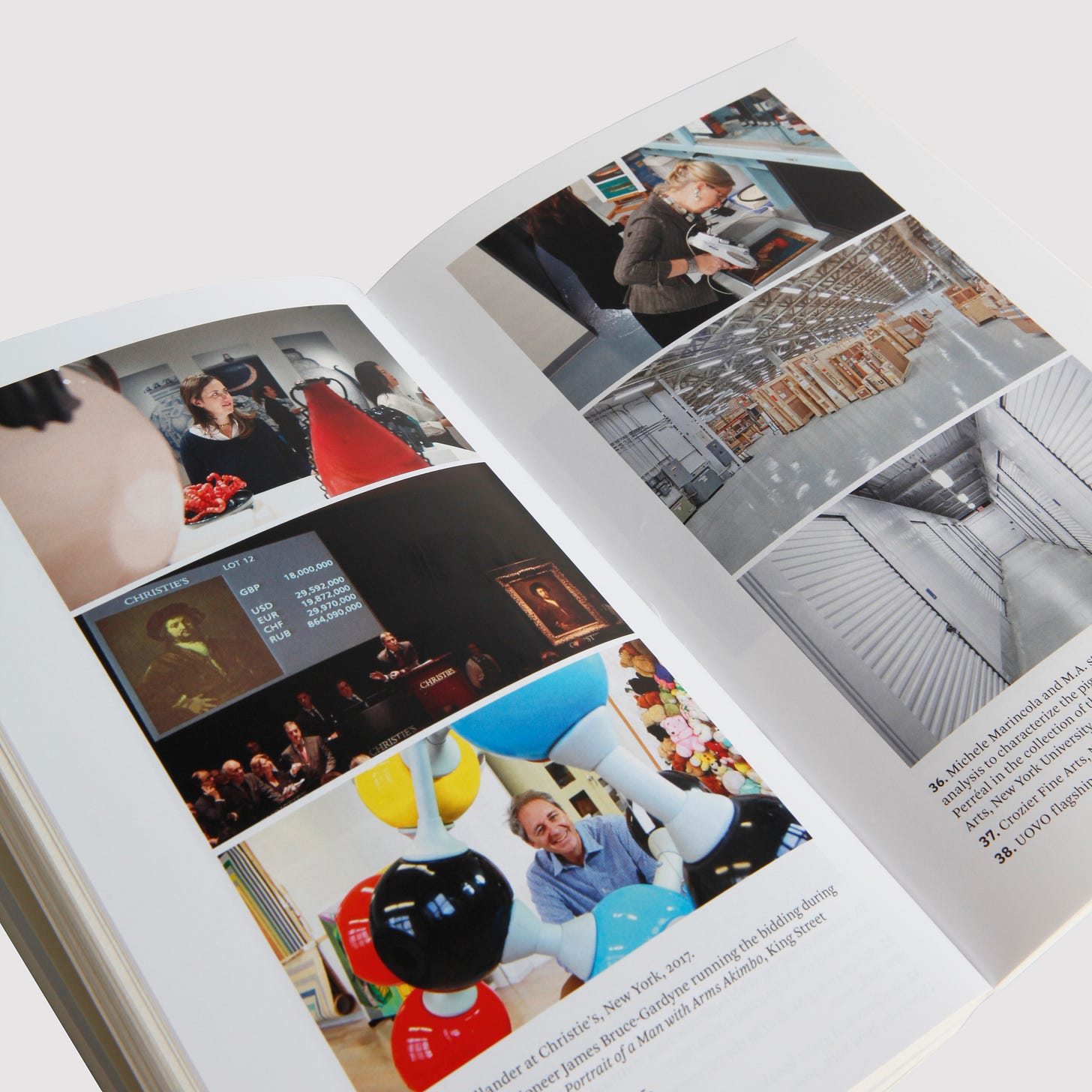Lucy Lippard's "Stuff," the state of art criticism, further AI education, art in offices, and "A Year in the Art World" paperback now available in the U.S.
This week's Art & Artists
Hi Everyone,
Hoping you’re well.
Without further ado, I’m excited to continue to share with you some of the highest-quality art content out there…
Lucy Lippard’s memoir
I wanted to start with the news of the release of Stuff: Instead of a Memoir, an anti-memoir memoir by Lucy Lippard, one of my personal art history heroes—who I hope is (or will be) one of yours too.
The first art history book I ever read was Lippard’s Pop Art, and her exhibition and book on the Vietnam War, A Different War, ended up being the catalyst for my book, Kill for Peace. (I am still so humbled that she endorsed my book and I can’t tell you how scared I was to show it to her to review when it was done…I was so hoping she felt it was a worthwhile project…)
Hyperallergic has published an excerpt/teaser of the book that gives a little clue into what’s in it. And here’s a summary, via NYU Press…
“Stuff: Instead of a Memoir is a short, abundantly illustrated autobiography of the American art writer, activist, and sometime curator Lucy R. Lippard. Describing tchotchkes, photographs, and art in her unpretentious New Mexico home, the author informally narrates key events and relationships in her 86-year-long, highly creative life, starting with her family roots and her childhood in New York, Louisiana, Virginia, and Maine. Through anecdotal and often humorous memories, we follow the author through her youth, adulthood, relationships, and her thirty-five years in New York City, where she organized dozens of exhibitions, authored hundreds of articles, and co-founded Heresies: A Feminist Journal of Art and Politics, the artist’s-book center Printed Matter, and activist artists group PAD/D. Lippard touches on the roles she played in Conceptual Art and the Feminist Art movement in the 1960s through the 1980s. Her accounts of more recent years focus on the art, landscape, culture, and communities of the American Southwest, where she moved in the early 1990s. This “anti-memoir” also mentions Lippard’s twenty-five books, but few of her many honors.”
As they say, don’t think, just do—and in this case, just buy this book.
“Negative Criticism”
I’d be remiss as an educator regarding contemporary art to not point you toward Sean Tatol’s recent “Negative Criticism: A Sentimental Education,” which was published in July in The Point. For one, the influential collector Alain Servais called it “the best text on art criticism” he has ever read. Wow.
It also prompted a two-part column by Artnet’s Ben Davis in response.
I’m honestly still processing Tatol’s piece and don’t yet have my own thoughts on it. (I’m, as I have said previously, a slow thinker—hence my book writing, not reporting so much anymore). I have read Tatol’s column a couple of times and plan to read it another time to really digest the argument.
The gist of it is Tatol reflecting on his maturation as an art critic and defending his Manhattan Art Review, most well-known for its “Kritic’s Korner,” which grades gallery shows from 1-5 stars and often features negative reviews. Tatol is basically arguing for more negative criticism, or at least criticism that counsels people whether something is good or bad art, for he believes by not doing so—and this is what he thinks is happening in the current critical environment—you’re not serving the true function of a critic, which is to help people understand art and to know what to pay attention to and not.
He explains:
Writing about art can have any number of objectives, but lurking behind any analysis is the question of judgment. Most contemporary art writing uses interpretation as a way of sidestepping the problem of quality, but interpretations are impossible to take seriously if the art itself is bad. A critic who avoids evaluation may have a less contentious body of work; perhaps they will protect themselves from ever saying anything that will sound embarrassing to future generations. The cost is that they won’t be able to help their readers learn how to judge art or to understand it, which are in essence the same thing. In my judgments of particular art shows I convey my understanding of art, or of good art, which I can only hope is of some use to others interested in developing their own taste. The goal of the Review has been to provide a quixotic counterweight to the prevailing conventions of art and commentary about art, which might otherwise, in their greed, indifference, and literal-minded sloganeering, counsel cynicism.
More here.
Before moving on from the subject of art criticism, I also wanted to recommend the just-released Track changes: a handbook for art criticism published by Paper Monument and edited by Mira Dayal and Josephine Heston.
I’m a fan of Paper Monument’s past books, especially Draw it with Your Eyes Closed: The Art of the Art Assignment and in general, (good) books about art writing. In A Year in the Art World, I specifically chose to interview Jarrett Earnest because of his 2018 (good book on art writing) What it Means to Write About Art.
Track changes features twenty-five art writers’ and editors’ strategies for critical writing and editing “that encourage solidarity and reparative decision-making to actively challenge structural inequalities within the art world.” Contributors are Kemi Adeyemi, Andy Campbell, Erica Cardwell, Re’al Christian, Aruna D’Souza, Leslie Dick, Amy Fung, Merray Gerges, Annie Godfrey Larmon, Ariel Goldberg, Yves Jeffcoat, Dana Kopel, Yaniya Lee, Dessane Lopez Cassell, Jessica Lynne, Tausif Noor, Ashley Stull Meyers, Lindsay Preston Zappas, Kristina Kay Robinson, Jillian Steinhauer, Ana Tuazon, Monica Uszerowicz, Wendy Vogel, Emily Watlington, and Elisa Wouk Almino.
Another “don’t think, just buy” scenario :) if you’re into this subject. More here.
More AI Education
As I have previously stated, one of my recent personal foci is gaining a deeper understanding of the (potential) overlap between AI and the art world. Within this search I recently came across a new book by Mustafa Suleyman, a co-founder of Deep Mind called The Coming Wave: Technology, Power, and the Twenty-first Century’s Greatest Dilemma, which I would like to recommend. The Guardian, which featured an interview with Suleyman last week, succinctly summarized the book (and what Suleyman thinks will happen with AI) in the following way:
“AI, Suleyman argues, will rapidly reduce the price of achieving any goal. Its astonishing labour-saving and problem-solving capabilities will be available cheaply and to anyone who wants to use them. He memorably calls this ‘the plummeting cost of power.’ If the printing press allowed ordinary people to own books, and the silicon chip put a computer in every home, AI will democratise simply doing things. So, sure, that means getting a virtual assistant to set up a company for you, or using a swarm of builder bots to throw up an extension. Unfortunately, it also means engineering a run on a bank, or creating a deadly virus using a DNA synthesiser.”
The jury’s out regarding what AI means for art and the art world. On one hand, it may mean absolutely nothing. In my decade-plus-long experience with contemporary art and technology, the art world has been incredibly fast to talk about new tech but very slow to actually adopt it. The art world is also such a white-glove, service-based industry focused on the ultra-wealthy where so much of the emphasis is on everything that cannot be automated (and emphasizing this fact), e.g. through the presentation of unique hand-made objects, one-of-a-kind experiences, and customer/donor/client/patron relationships that are as personal and intimate as possible.
At the same time, I think we have all seen artists experimenting with AI-generated images, and there is at least buzz around these even if there is not much of a market for them as of yet. There has also been some immediate application of AI in art authentication, though there seem to be a lot of problems and debate happening in the space already because of it. For example, see the recent battle of AIs regarding the authentication of a Raphael here.
A lot more to discuss on this subject, and I will definitely be coming back to this in future weeks.
Art in offices
Oli Stratford recently published a “Comment” in Apollo regarding whether the use of art in offices will bring people back to them, and I thought this was worth noting.
Stratford evaluates two publications, Gideon Haigh’s The Office: A Hardworking History (2012) and Brookfield Properties’ September 2022 publication Art of the Workplace to come to the following conclusion:
While an office can sometimes be about community, it is always about work. In fact, even the idea of the office as a specific building typology is comparatively recent. ‘The office did not come into being like the spinning jenny or the factory system,’ Haigh explains. ‘It was first an area—in a warehouse, in a store, in a home—cleared for keeping a ledger or writing a letter. Office functions are as old as commerce; the customised physical location is a far more recent development.’ This, Haigh notes, is the essential truth at the heart of the office – ‘it was an activity long before it was a place’—and the rise of hybrid working has seen a resurgence of this sense that work is labour, not locale. The addition of art to offices, however ‘nurturing’ it may be, will do little to change this.
On one hand, I agree with Stratford. Work is work, and regardless of how much you dress up an office, it is still a place of work, not truly a place to hang out.
At the same time, I think Stratford—and granted his was a short piece based on two pieces of literature—misses a lot of the opportunities art in offices provided (and hopefully will continue to provide) for people, artists, and for corporations. I’m obviously biased, based on my experiences leading such an effort at Meta, but art in offices can offer real creative inspiration and provocation for people trying to “change the world” (and I mean this in the best sense). Offices also provide a venue for some spectacular works of art, many of which unfortunately the public does not see, but it doesn’t downgrade their value. (A case in point is Timur Si-Qin’s Sacred Footprint, which my colleague Xinran Yuan of Meta Open Arts curated and installed last year at the Farley Building in New York City.)
One related big question that’s been on my mind since COVID, and since my Meta layoff is what is the future of corporate art programs? If there is no art in workplaces, and that seems to be one way things are going right now, this eliminates one of the major ways in which people engage with art and one of the major ways in which art is consumed/patronized (by corporations). What replaces it? Or does nothing replace it? And do we really think that people are able to substitute it with art in their own private spaces? Also, do we even have a sense of the full impact of corporate art patronage on the art market to understand the current and lasting effect? I seem to think it’s one of those figures which we won’t ever know but will be very significant. Obviously more to discuss here too…
A Year in the Art World now available in the U.S. in paperback
Finally, I’m excited to promote a new version of my book, A Year in the Art World.
You may recall in June I announced the paperback version was being released in the U.K. and I am happy to share that next week (9/19) the book will be available in the U.S.
As I wrote previously, A Year in the Art World was first published in a less-than-desirable environment—in September 2020—in the middle of the pandemic. Accordingly, I am, for one, especially excited to re-share it in an environment where people can actually see the book in real life :). I also believe, even three years later now, that A Year in the Art World remains what it initially set out to be: an accessible overview of the contemporary art world.
I continue to be so thankful for the time and attention of all the people I interviewed for the book. And I hope, if you haven’t read it yet, that you may be so inclined to pick up the new paperback version. It will be available internationally in bookstores, online and off. (Thanks Thames & Hudson and W.W. Norton for the global distribution :))
That’s all for this week. See you again soon.
Best,
Matthew

